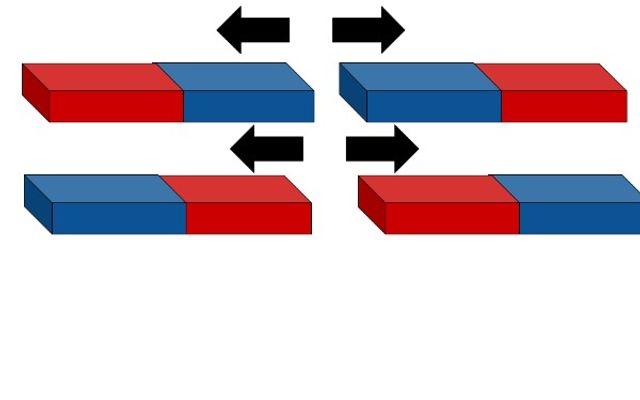7.1.1
Magnetic Materials
Magnetism
Magnetism
Magnetism describes the ability of magnets to attract (pull towards) and repel (push away) other magnets without touching them.


Attraction
Attraction
- Magnets have a north pole (N) and south pole (S).
- If two magnets are close enough to each other, then the south pole of one magnet will attract the north pole of the other magnet.
- This is an example of a non-contact force.


Repulsion
Repulsion
- If one magnet is turned so that both south poles (or both north poles) are close together, then the magnets will repel each other.
- Opposite poles on a magnet attract and like poles on a magnet repel. This is an example of a non-contact force.


The poles of a magnet
The poles of a magnet
- A magnet's poles are where the magnetic forces are strongest.
Magnetic Materials
Magnetic Materials
Iron, nickel and cobalt are the only pure metals that can be turned into a magnet. These metals are “magnetic materials”.


Properties of magnetic materials
Properties of magnetic materials
- Magnetic materials, like iron, don’t always act as magnets.
- For example, a normal piece of iron won’t attract (pull) or repel (push) another piece of iron.
- But magnetic materials, like iron, are attracted to a magnet if they are close enough to the magnet.


Properties of magnetic materials
Properties of magnetic materials
- Magnetic materials can be attracted by a magnet, but can’t be repelled by a magnet.
- Only two magnets can repel each other.
- Non-magnetic materials will never be attracted to magnets.
- Permanent magnets are always magnetic, even when they are not near other magnets.
- They produce their own magnetic field.
Induced Magnetism
Induced Magnetism
A magnetic material will temporarily become a magnet when it is close to a permanent magnet. There is always an attractive force between an induced magnet (or magnetic material) and a permanent magnet.
-min,h_400,q_80,w_640.jpg)
-min,h_400,q_80,w_640.jpg)
Induced magnetism
Induced magnetism
- Induced magnets are magnetic materials that become magnets when they are in a magnetic field.
- When moved away from the permanent magnet, the magnetic material will stop being a magnet.
- This is called induced magnetism.


Poles
Poles
- The permanent magnet induces (creates) temporary poles in the magnetic material and these align so that the magnetic material is attracted to the permanent magnet.
- If the north pole of the magnet is next to the magnetic material, then a south pole will be induced in the part of the material closest to the magnet.
1Energy
1.1Energy Changes
1.1.1Energy Stores
1.1.2Calculating Changes in Energy
1.1.3Changes in Kinetic Energy - Calculations
1.1.4Changes in GPE - Calculations
1.1.5Changes in EPE - Calculations
1.1.6Energy Transfers
1.1.7Mechanical Work Done
1.1.8Mechanical Work - Calculations
1.1.9Electrical Work Done
1.1.10Electrical Work Done- Calculations
1.2Energy Losses & Efficiency
2Electricity
2.1Electric Charge
2.2Resistance & Electrical Work
2.3Electric Circuits
2.4Electricity in Homes
2.5Static Electricity
3Particle Model of Matter
3.1States of Matter
3.2Heat
4Atoms & Radiation
4.1Atoms
4.2Radiation
4.2.1Radioactive Decay
4.2.2Radioactive Decay 2
4.2.3Types of Radioactive Emission
4.2.4Fission & Fusion
4.2.5Radioactive Decay Equations
4.2.6Radio. decay equations - Calculations
4.2.7Half Lives & Ionising Radiation
4.2.8Half Life - Calculations
4.2.9Uses & Dangers of Radiation
4.2.10Uses & Dangers of Radiation 2
4.2.11End of Topic Test - Atoms & Radiation
4.2.12Grade 9 - Radiation
4.2.13Exam-Style Questions - Radioactive Decay
5Forces
5.1Basics of Motion
5.2Forces
5.2.1Gravity
5.2.2Gravity - Calculations
5.2.3Resultant Forces
5.2.4Newton Second Law - Calculations
5.2.5Force Diagrams
5.2.6Free Body Diagrams - Calculations
5.2.7Stretching a Spring
5.2.8Hooke's Law
5.2.9Hooke's Law - Calculations
5.2.10Elastic Potential Energy
5.2.11Elastic Potential - Calculations
5.2.12Exam-Style Questions - Elastic Potential Energy
5.3Effects of Forces
6Waves
6.1Wave Basics
6.2Waves at a Boundary
6.3Sound Waves
6.4Electromagnetic Waves
7Magnetism
7.1Magnetism Basics
7.2Electromagnetism
Jump to other topics
1Energy
1.1Energy Changes
1.1.1Energy Stores
1.1.2Calculating Changes in Energy
1.1.3Changes in Kinetic Energy - Calculations
1.1.4Changes in GPE - Calculations
1.1.5Changes in EPE - Calculations
1.1.6Energy Transfers
1.1.7Mechanical Work Done
1.1.8Mechanical Work - Calculations
1.1.9Electrical Work Done
1.1.10Electrical Work Done- Calculations
1.2Energy Losses & Efficiency
2Electricity
2.1Electric Charge
2.2Resistance & Electrical Work
2.3Electric Circuits
2.4Electricity in Homes
2.5Static Electricity
3Particle Model of Matter
3.1States of Matter
3.2Heat
4Atoms & Radiation
4.1Atoms
4.2Radiation
4.2.1Radioactive Decay
4.2.2Radioactive Decay 2
4.2.3Types of Radioactive Emission
4.2.4Fission & Fusion
4.2.5Radioactive Decay Equations
4.2.6Radio. decay equations - Calculations
4.2.7Half Lives & Ionising Radiation
4.2.8Half Life - Calculations
4.2.9Uses & Dangers of Radiation
4.2.10Uses & Dangers of Radiation 2
4.2.11End of Topic Test - Atoms & Radiation
4.2.12Grade 9 - Radiation
4.2.13Exam-Style Questions - Radioactive Decay
5Forces
5.1Basics of Motion
5.2Forces
5.2.1Gravity
5.2.2Gravity - Calculations
5.2.3Resultant Forces
5.2.4Newton Second Law - Calculations
5.2.5Force Diagrams
5.2.6Free Body Diagrams - Calculations
5.2.7Stretching a Spring
5.2.8Hooke's Law
5.2.9Hooke's Law - Calculations
5.2.10Elastic Potential Energy
5.2.11Elastic Potential - Calculations
5.2.12Exam-Style Questions - Elastic Potential Energy
5.3Effects of Forces
6Waves
6.1Wave Basics
6.2Waves at a Boundary
6.3Sound Waves
6.4Electromagnetic Waves
7Magnetism
7.1Magnetism Basics
7.2Electromagnetism

Unlock your full potential with GoStudent tutoring
Affordable 1:1 tutoring from the comfort of your home
Tutors are matched to your specific learning needs
30+ school subjects covered